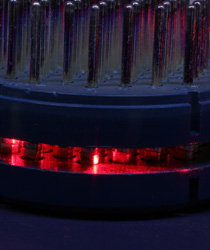New optical gas sensors
Among the types of gas sensors currently under study, research undertaken during the NANOPHOS project was focused on optical sensors. Zinc oxide thin film sensors have grown increasingly attractive for detection of small concentrations of both reducing and oxidising gases, due to their high sensitivity and selectivity. When gas components interact with the sensitive film surface, changes in its chemical or physical properties are observed. The possibility of improving the precision of gas concentration measurements was explored by project partners at Institutul National de Cercetare-Dezvoltare pentru Fizica Laserilor, Plasmei si Radiatiei in Romania. Various basic materials, such as zinc oxide (ZnO), silicon dioxide (SiO2) and metal acetylacetonates, and their combinations had been tested and studied in the past for this purpose. NANOPHOS project partners isolated ZnO, highly transparent in the visible wavelength range, as a promising candidate. The refractive index of ZnO sensing media changes upon reaction with reducing gases, including hydrogen (H2), nitrogen oxides (NOx) and sulphur oxides (SOx). By Pulsed laser deposition (PLD), SiO2 substrates of high transparency in the visible and near infrared region of the electromagnetic spectrum were coated with a ZnO thin film. A KrF excimer laser light source with a wavelength of 248nm was used to deposit high quality ZnO, as well as gold (Au)-doped ZnO thin films. The response of ZnO films, used as sensing elements, was then tested for different concentrations of butane diluted in nitrogen by the m-line detection technique. Butane concentrations as low as 100ppm were detected, opening the way for the development of optical gas detectors with compelling advantages over conventional electrical devices. Integrated into a miniaturised optical gas sensor by means of Integrated optical circuits (IOC), they could provide a promising alternative solution.







